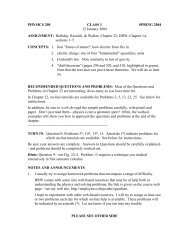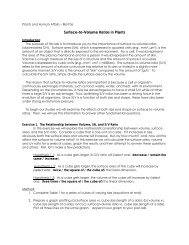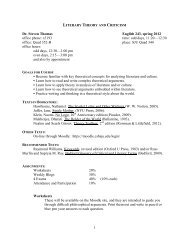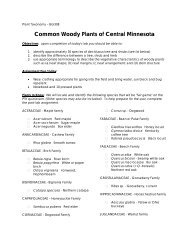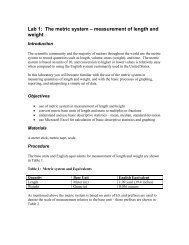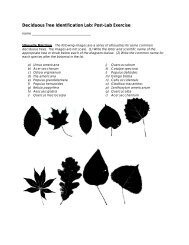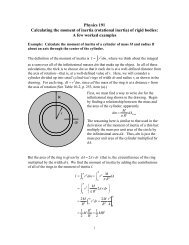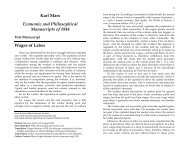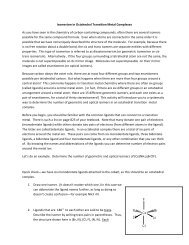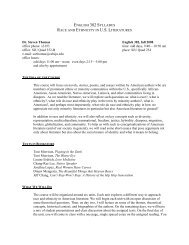atio <strong>of</strong> Kool-Aid to water (the Kool-Aid’s concentration) is very high. As you add more water,the ratio <strong>of</strong> Kool-Aid to water decreases and the solution becomes lighter in color. Thus, theintensity <strong>of</strong> color is directly related to concentration <strong>of</strong> Kool-Aid. A spectrophotometer canmeasure the amount <strong>of</strong> light absorbed by a solution, and the quantity <strong>of</strong> light absorbed isproportional to the intensity <strong>of</strong> color or pigment in the solution.A second principle involved in spectrophotometery is that the amount <strong>of</strong> light absorbed isalso dependent on through how much <strong>of</strong> the solution the light must pass. If you pour the GrapeKool-Aid into a slender test tube and compare its color to Grape Kool-Aid poured into a drinkingglass, the Kool-Aid in the drinking glass will appear darker in color. This is because as lighttravels through the liquid more and more light is absorbed by the Kool-Aid and less light istransmitted.The spectrophotometer measures absorbance. Absorbance values, by themselves, do notdescribe the concentration <strong>of</strong> a substance. However, we can determine the concentration <strong>of</strong> asubstance in a solution using a standard curve. A standard curve translates absorbance valuesinto concentration. See Fig 2.1 for an example. We can construct a standard curve by makingsolutions with a known concentration <strong>of</strong> the substance we are measuring and then measuring theirabsorbance. Graphing the concentration on the x-axis and the absorbance on the y-axis, we cansee that there is a linear relationship between concentration and absorbance. Thus a standardcurve is not really a curve, but a straight line. Beers Law describes this linear relationship:A = εCLWhere A = absorbanceε = molar absorptivity <strong>of</strong> the substance (how much light it absorbs at thewavelength used)C = concentration (for clinical measurements, the concentration <strong>of</strong>ten used ismg/dl)L = pathlength (the length the light travels through the cuvette—remember theslim cuvette versus drinking glass)1.41.21Absorbance0.80.60.40.200 5 10 15 20 25 30Concentration (mg/dL)Fig 2-1. Example <strong>of</strong> standard curveUsing the standard curve, we can determine the concentration <strong>of</strong> other solutions, by locating theabsorbance <strong>of</strong> that solution on the y-axis and drawing a horizontal line to the standard curve line.Then you can draw a vertical line from that intersection to the x-axis to determine theconcentration.M:\Macvol\Courses\Biol 114.F03\<strong>Lab</strong>\<strong>Lab</strong>2.spec\lab.2.writeup.03.doc - 2 -
It is also possible to calculate the concentration if we know the slope <strong>of</strong> the standardcurve. In the equation for a straight line, y= mx +b, m is the slope <strong>of</strong> the line. The equation forBeer’s Law also describes a straight line with an intercept <strong>of</strong> zero. Absorbance is measured onthe y-axis, concentration on the x-axis and the value εL comprise the slope (m). An alternativeway to determine the concentration <strong>of</strong> a substance is to rearrange Beer’s Law, dividing theabsorbance <strong>of</strong> the solution by the slope <strong>of</strong> the standard curve:AC = ε LWe assume that the y-intercept is zero. In other words we are assuming that theabsorbance <strong>of</strong> a solution is zero when none <strong>of</strong> the substance we are measuring is present. Inreality, that is not always the case. If we are measuring the concentration <strong>of</strong> Grape Kool-Aid,other substances might be present that absorb light. If this occurred, our y-intercept would not bezero. Thus when we are using a spectrophotometer we need to calibrate it so that when none <strong>of</strong>the substance we are measuring is present, the absorbance that is measured is zero. We do this byusing a blank. A blank solution contains all the substances present in the solution except thesubstance to be measured. Before making measurements with the Spec 20, the blank ismeasured, and its absorbance value is set to zero. For example, if we are measuring theconcentration <strong>of</strong> Grape Kool-Aid, the blank should be made <strong>of</strong> water and sugar, the otherconstituents in the solution. By using a blank, if water or sugar absorbs light, that absorption willbe set to zero, and thus the y-intercept on our linear Beer’s Law equation would indeed be zero.Procedure<strong>Spectrophotometric</strong> Technique (See Fig 2-2)1. Plug in the spectrophotometer and turn it on by turning the left dial clockwise. Allow thespectrophotometer to warm up at least 5 minutes before proceeding.2. Set the wavelength dial to 600 nm. This is a wavelength <strong>of</strong> light that gets absorbedreadily by the pigment in the Grape Kool-Aid.3. With no vial in the spectrophotometer, the light path is closed. Therefore no light istransmitted, or in other words there is an infinite absorption. With the on/<strong>of</strong>f dial (leftdial) set the needle to read infinity (∞) on the absorbance scale.4. Now fill a cuvette (a small test tube that is 12 mm in diameter and 100 mm in length)with Blank 1. This solution should contain all the constituents except the substance to bemeasured. Since we are measuring Grape Kool-Aid, Blank 1 contains the otherconstituents, sugar and water, in the same proportion as are found in the Grape Kool-Aid.5. Insert the cuvette containing Blank 1 into the sample chamber. As you do the light pathwill be opened. This blank solution does not contain any Grape Kool-Aid, and so theabsorbance should be set to zero. Use the right knob to set the absorbance to zero.6. Next fill a cuvette with Grape Kool-Aid test solution. Insert it into the spectrophotometerand record its absorbance in question number one <strong>of</strong> your assignment.7. Next, fill a cuvette with Blank 2 solution and repeat steps 5 and 6. Is there a difference inthe measurements <strong>of</strong> the same solution? How can you explain it?M:\Macvol\Courses\Biol 114.F03\<strong>Lab</strong>\<strong>Lab</strong>2.spec\lab.2.writeup.03.doc - 3 -



